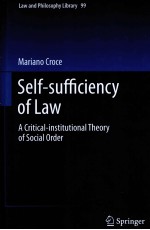

SELF-SUFFICIENCY OF LAWPDF电子书下载
- 电子书积分:10 积分如何计算积分?
- 作 者:MARIANO CROCE
- 出 版 社:SPRINGER
- 出版年份:2012
- ISBN:9400742975
- 页数:216 页
Part Ⅰ Law as a Complex Practice: The Rule-Based Model 5
1 Legal Theory as a Scientific Discipline and the Variety of Rules 5
1.1 Preliminary 5
1.2 Austin and the Autonomy of Legal Theory 6
1.3 Kelsen and the Scientific Amendment of Legal Positivism 10
1.4 Beyond Commands and Imperatives: The Puzzle of Secondary Rules 13
2 Legal Validity and the Problem of Rule-Acceptance 19
2.1 Preliminary 19
2.2 Four Notions of Acceptance 21
2.3 The Ambiguities of Acceptance as Observance 27
3 Reflective Acceptance: Reasons for Action and Criterion-Rules 31
3.1 Preliminary 31
3.2 Internal Point of View and Rule-Government 33
3.3 Rules as Reasons for Action 36
3.4 Habits, Rules and the Limits of Hart's Approach 38
3.5 A Quasi-Wittgensteinian Reading of the Practice Theory 41
3.6 Criterion-Rules and Conditions of Thinkability 46
4 The Legal Practice and Its (Vanishing) Borders 49
4.1 Preliminary 49
4.2 The 'Payne Problem': Relevant Population and Lay People 50
4.3 Rule-Based Model of What? 54
4.4 Law as a Practice Among Practices 60
Part Ⅱ Law as a Selective Practice: The Social and the Legal 67
5 The Pluralist Divide 67
5.1 Preliminary 67
5.2 The Reasons for Legal Pluralism: Pragmatic and Conceptual Arguments 68
5.3 First Type of Pluralism: Law as Organisation 71
5.3.1 Eugen Ehrlich: The Living Law of Associations 72
5.3.2 Santi Romano: Institutions as Legal Orders 76
5.4 Second Type of Pluralism: The Artificial Character of Law 79
5.4.1 Sally Falk Moore: The Dialectic Spontaneity/Artificiality 79
5.4.2 Marc Galanter: The Historicity of Legal Borders 83
5.5 Third Type of Pluralism: The Dissolution of Legal Pluralism 86
5.5.1 Sally Engle Merry: Law as Frame of Significance 87
5.5.2 Brian Tamanaha: The Praxiological Way-Out 90
5.6 Legal Pluralism: A Provisional Assessment 94
6 Legal Pluralism Revised: Law as the Product of Selection 99
6.1 Preliminary 99
6.2 The Root of All Evils: The Malinowski Problem 99
6.3 Legal Selection and Legitimate Coercion: Hoebel's View 105
6.4 Towards a Concept of Law as a Selective Practice 111
7 Classic Institutionalism: Jural Reality and Legal Selection 113
7.1 Preliminary 113
7.2 Institutions, Inner Orders, and Romano's Dilemma 114
7.3 Jural Reality and Official Law 119
7.4 Integrating Institutionalism: Thin Functionalism 125
8 Exploring the Jural Continuum 127
8.1 Preliminary 127
8.2 The Background of Social Practices 128
8.3 Criterion-Rules, Instance-Rules, Norm-Rules 132
8.4 The Jural Continuum: Practices, Institutions, Organisations 139
8.5 Relevant Population and Lay People Reconsidered 144
Part Ⅲ The Law as a Special Practice: Legal Field and Social Reality 151
9 Negotiating Reality: Knowledge and Categories in the Legal Field 151
9.1 Preliminary 151
9.2 Law as a Trans-Sectional Venue 152
9.3 Law and Its Custodians: The Paradigmatic Case of the Roman ius 157
9.4 The Semiotic Circuit of Law: The Intriguing Case of Mekgwa Le Melao 162
9.5 Is Productive Circularity Really Distinctive? A Theoretical Objection 167
9.6 The Indispensable Self-sufficiency 173
10 The Ritual Dimension of Law: Normality, Normativity, and Critique 177
10.1 Preliminary 177
10.2 Ritual and the 'Question of Plausibility' 178
10.3 Law's Nondiscursive Dimension: Normality and Normative Facts 187
10.4 Law's Discursive Dimension: The Space for Critique 190
Epilogue 195
Defending a Pluralist Critical-Institutional View of Law 195
Bibliography 201
Author Index 209
Subject Index 213
- 《1871-1915年意大利史》(意)贝内德托·克罗齐(Benedetto Croce)著;王天清译 2005
- 《十九世纪欧洲史》(意)贝内德托·克罗齐(Benedetto Croce)著;田时纲译 2005
- 《美学原理》(意)克罗斯(B.Croce);李天纲主编 2017
- 《美学或艺术和语言哲学》(意)克罗齐(Croce,Benedetto)著;黄文捷译 1992
- 《RESEARCH COLLECTION ON CORONARY INTERVENTIONS AND SYNDROMS》NEVILLE KUKREJA AND MARIANO BRIZZIO 2014
- 《COMPUTATION OF CURVES AND SURFACES》WOLFGANG DAHMEN MARIANO GASCA CHARLES A.MICCHELLI 2222
- 《GOVERNING SECURITY THE HIDDEN ORIGINS OF AMERICAN SECURITY AGENCIES》MARIANO-FLORENTINO CUELLAR 2013
- 《MATHEMATICAL ANALYSIS LINEAR AND METRIC STRUCTURES AND CONTINUITY》MARIANO GIAQUINTA AND GIUSEPPE MODICA 2007
- 《THE LEGAL THEORY OF CARL SCHMITT》MARIANO CROCE AND ANDREA SALVATORE 2013
- 《SELF-SUFFICIENCY OF LAW》MARIANO CROCE 2012
